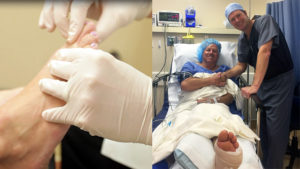Diabetic Foot Ulcer: Diagnosis and treatment
Diabetic foot ulcer and a common and serious condition of type 1 and type 2 diabetes1. Diabetes is associated with several complications - ischemia, neuropathy and deformities, leading to a particularly high risk of developing a foot ulcer and a low probability of its healing.
Due to the limited blood supply to the lower limbs, diabetic foot ulcers are prone to necrosis and infection and likely to reach deep tissues, including bones. Routine management and monitoring of diabetic patients are paramount to minimize the risk of chronic complications, including the neuropathic foot. The main objective of diabetic foot treatment is undoubtedly to control plantar ulcers and, in the case of continuous infection, to stem the pathogenic insult within the shortest possible time. Diabetic Foot Ulcer Treatment approaches include debridement, protection from trauma, treatment of infection, control of exudate and stimulation of wound healing.
Diagnosis
The clinical evaluation of people with diabetes includes several tests.
Medical history and physical examination: The patient's medical history and physical examination make up the patient's business card. In this way, the Foot doctor recognizes the seriousness of the situation. Physical examinations include assessing the patient's vital signs (temperature, heart rate, blood pressure, respiratory rate) and testing limb sensitivity (often changing in diabetes) and inspection of the trajectory of the lower limbs.

Laboratory tests: An important laboratory test (blood test) to determine the presence of an infection or other blood disorder. Depending on the severity of the situation, a specialist may ask the patient to perform more detailed tests such as liver enzyme tests or renal function tests.
X-ray: Indicates that the soft tissue may have bone damage (such as arthritis) or a foreign body (soft tissue gas may indicate a case of gas rupture).
Ultrasonography: If desired, doctors can use an echo puller to assess the condition of blood vessels in patients with diabetic feet (morphological and structural analysis).
Angiography: A screening test that helps obtain a representation of blood vessels in the body by injecting a contrast agent into the blood vessels.
Care and treatment
Due to the severity of the condition, treatment of diabetic feet requires an interdisciplinary assessment involving a team of diabetic physicians, Irvine podiatrists, and surgeons.
People with diabetes should follow all the instructions of a foot surgeon in orange county ca to implement an effective preventive program that can reduce the risk of foot injuries such as octopus and infections.
Untreated ulcerous lesions of the diabetic foot significantly reduce the chances of recovery and cause gangrene in the patient, resulting in the risk of amputation of the foot. You can also buy New Balance Diabetic Shoes.
For ingrown toenails, Ingrown Toenail Surgery includes an outpatient procedure to remove ingrown toenails using phenol or trichloroacetic acid. For toenails with grown fungus, Toenail Fungus Laser treatment can be used.
The ethical obligation of diabetics is to contact your doctor as soon as you notice or notice any abnormal signs or symptoms of your feet. The patient should always write all changes observed and perceived in the extremities in a notebook. This facilitates subsequent diagnosis by the doctor.